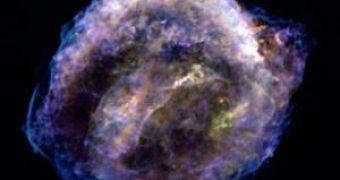NASA's Chandra X-ray Observatory revealed for astronomers a stunning new image of one of the youngest supernova remnants in the galaxy, solving a long-standing mystery and shedding light for understanding how a star dies and for measuring the expansion of the universe.
Since 1600's, sky watchers, including the famous Johannes Kepler, observed a shiny new object in the night sky.
As there were no telescopes, the watchers could only notice a new star that was initially brighter than Jupiter dimming over the following weeks.
Nine days of Chandra observations resulted in an X-ray image of unprecedented detail of one of the most spectacular supernovas in the Milky Way galaxy.
Astronomers have studied Kepler remnants of the explosion intensively over the past three decades with radio, optical and X-ray telescopes, but its origin remained mysterious.
The presence of large amounts of iron and the lack of a detectable neutron star points toward a Type Ia supernova, when a white dwarf star expels material from an orbiting companion until the white dwarf becomes unstable and is destroyed by a huge explosion.
But the remnants appeared expanding into dense material that is rich in nitrogen, which points to a different type of supernova ("Type II"), caused by the collapse of a single massive star that sheds material before exploding.
A team of astronomers, led by Stephen Reynolds of North Carolina State University in Raleigh, N.C., was able to use the Chandra dataset to address this mystery.
In the new study, the team could compare the relative amounts of oxygen and iron atoms in the supernova, finding it a Type Ia supernova.
Kepler is the only Type Ia explosion which occurred in more massive progenitors only about 100 million years after the star formed rather than several billion years.
This find changed the way Type Ia stars were regarded, as "standard candles" for cosmological studies of dark energy, as well as to understand their role as the source of most of the iron in the universe.
The new Kepler's image depicts in red low-energy X-rays, which mark material dominated by oxygen, heated up by a blast wave from the star's explosion.
Yellow color points slightly higher energy X-rays, mostly iron emerged in the supernova, while green (medium-energy X-rays) shows other elements from the exploded star.
The blue color indicates the highest energy X-rays, generated by a shock front of the explosion.
Photo credit: NASA.

 14 DAY TRIAL //
14 DAY TRIAL //